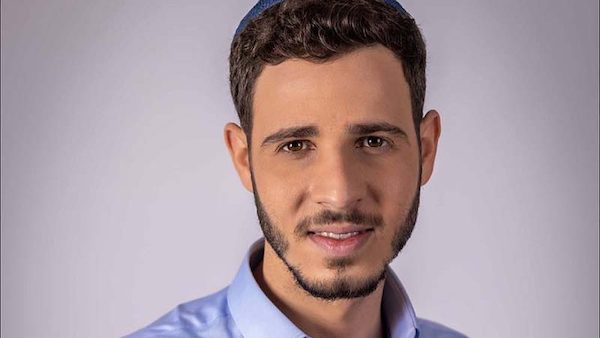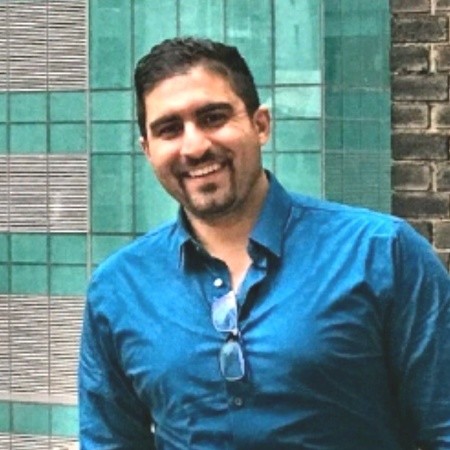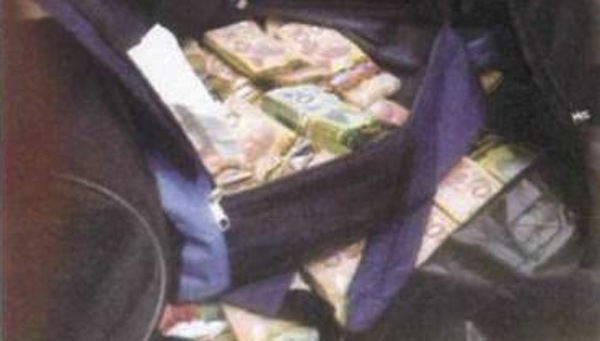Israeli journalist Yair Cherki (photo from Facebook)
Bravo Yair Cherki, the popular, ultra-Orthodox TV news reporter. He recently came out as gay in a wonderful social media post. In part, he said: “I write these words shaking, postponing to tomorrow. For next week. For after the holidays. Maybe it’s been 10 years since I’ve been writing and erasing…. And I write not because I have the strength to write but because I have no power to stay silent. I love men. I love G-d. It is not contradictory….”
His confession continues, “I live the conflict between my secular preference and my faith all the time. Some have solved the conflict for themselves by saying that there is no G-d, while others explain that there is no homosexuality. I know both exist. And I try to reconcile this contradiction within myself in various ways. These are things between G-d and me…. This is neither a fashion nor a trend nor a political statement. It is simply me….”
An intimate and intelligent statement.
* * *
Now, if this doesn’t take “blaming the Jews” to new extremes. In my previous article in the JI (jewishindependent.ca/land-of-milk-honey) I praised the historic maritime natural gas agreement between Israel and Lebanon, enabling both countries to drill for natural gas within their own territory. I truly wished Lebanon much success in hitting a gusher and creating their own Sovereign Wealth Fund.
Hezbollah’s leader Hassan Nasrallah sees it a bit differently, warning that any delay in Lebanon’s extracting gas from its own waters will be met by a punishing attack on Israel’s adjacent gas fields. Maybe Robert Frost’s poem “Mending Wall” will assuage Nasrallah: “I let my neighbour know beyond the hill…. And set the wall between us once again…. To each the boulders that have fallen to each…. He only says, ‘Good fences make good neighbours.’”
Nasrallah went on to threaten that if the United States continues spreading chaos within Lebanon – some conspiracy theory or other – that Israel will pay. Reminiscent of the Three Stooges slapstick routine when Curly slaps Larry for Moe slapping him.
Peace and prosperity for all, on both sides of the Fatima Gate. Otherwise known as the Good Fence!
* * *
Going once. Going twice. Do I hear $50 million? According to its website, “Sotheby’s is proud to offer … the earliest, most complete Hebrew Bible during this year’s marquee New York sales auction.”
The Codex Sassoon is more than 1,000 years old. According to Sharon Mintz, Sotheby’s senior Judaica specialist, in an interview with CNN, “this is the most important document to come to auction ever.” It’s expected to generate huge interest across the world from the wealthiest of bidders, with offers expected to reach as high as $50 million.
Other treasured documents fetching such modest amounts at auction include the Codex Leicester by Leonardo da Vinci (ostensibly his science diary) sold to Bill Gates in 1994 for about $31 million. And the first printing of the U.S. Constitution, bought by American hedge fund manager Kenneth Griffin in 2021 for about $43 million.
May 16 … save the date. And your shekels!
* * *
A few weekends ago, my wife and I drove south for the day to enjoy the year’s winter festival, Darom Adom, when the bright red poppies – a protected flower in Israel – come out in full bloom along the Gaza periphery. It’s another reason to celebrate with local handicrafts, seasonal fruit, local cheeses and wine, homemade Israeli cuisine.
Taking place not too far from Sderot, within the opened gates of local kibbutzim and moshavim (agricultural communities) and less than a kilometre from another good fence delineating the border between Israel and Gaza, the festival a testament to Israeli’s resilience – and longing for a peaceful coexistence.
Somewhat poetically, we purchased a beautifully handcrafted hamsa made by a young, local artist. This hand-shaped amulet is used for protection by both Jews and Muslims. In the Jewish faith, the five fingers of the hamsa represent the Five Books of Moses, or the Torah. The Muslim faith sees a hamsa as representing the Five Pillars of Islam (declaration of faith, prayer, alms, fasting, pilgrimage). In popular culture, the charm represents the five senses (sight, sound, smell, touch, taste).
* * *
Judicial reform. Judicial reform. Judicial reform. Sounds like Jan Brady whining about her sister getting all the attention, “Marcia. Marcia. Marcia,” from the 1970s sitcom The Brady Bunch. Judicial reform certainly has been getting all the attention lately.
Issues aside, we’ve had 10 weeks and counting of protests, with several hundred thousand Israelis protesting around the country every Saturday night against judicial reform. The protests are also aimed at the extreme, right-wing – even theocratic – makeup of the current coalition that is driving headstrong into judicial reform. And yet, the primarily secular, centre-left who comprise these thousands, waving Israeli flags and ending every protest with the singing of Hatikvah, respectfully wait until after Shabbat to begin their protests. How’s that for deep-bred regard for this Jewish tradition that crosses sociopolitical lines?
* * *
Bravo again to Yair Cherki. To come out in these turbulent, sociopolitical times for the Israeli LGBTQ+ community. With our far-right, xenophobic, theocratic and anti-LGBTQ+ government, Cherki’s post and testament to himself is nothing short of brave, beautiful and brilliant.
Bruce Brown is a Canadian and an Israeli. He made aliyah … a long time ago. He works in Israel’s high-tech sector by day and, in spurts, is a somewhat inspired writer by night. Brown is the winner of the 2019 AJPA Rockower Award for excellence in writing, and wrote the 1998 satire An Israeli is…. Brown reflects on life in Israel – political, social, economic and personal.





